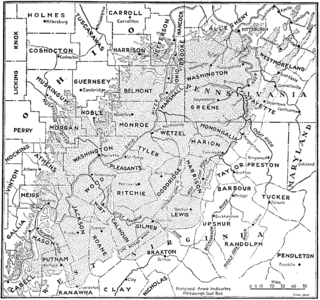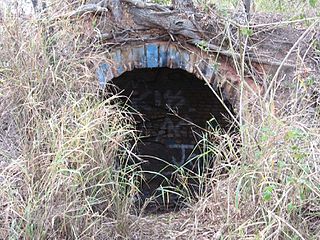
Coke is a grey, hard, and porous coal-based fuel with a high carbon content. It is made by heating coal or petroleum in the absence of air. Coke is an important industrial product, used mainly in iron ore smelting, but also as a fuel in stoves and forges.

Greensboro is a borough in Greene County, Pennsylvania, United States. The population was 267 at the 2020 census, up from 260 at the 2010 census.

Turkey Run State Park, Indiana's second state park, is in Parke County in the west-central part of the state along State Road 47, 2 miles (3.2 km) east of U.S. 41.

The Little Miami River is a Class I tributary of the Ohio River that flows 111 miles (179 km) through five counties in southwestern Ohio in the United States. The Little Miami joins the Ohio River east of Cincinnati. It forms parts of the borders between Hamilton and Clermont counties and between Hamilton and Warren counties. The Little Miami River is one of 156 American rivers designated by the U.S. Congress or the Secretary of the Interior as a National Wild and Scenic River and lends its name to the adjacent Little Miami Scenic Trail.

Brown County State Park is located in the United States in the center of the southern half of the state of Indiana. The park is by far the largest of 24 state parks in Indiana, and occupies 15,776 acres (63.84 km2)—making it one of the larger state parks in the United States. It is among Indiana's most visited state parks with about 1.2 million visitors annually. Although Bloomington, Indiana, is the closest city, the park is closer to the small town of Nashville in Brown County. Brown County is named for General Jacob Brown, who fought in the War of 1812 and became Commanding General of the United States Army.

Shades State Park is a state park in Montgomery, Parke, and Fountain Counties in Indiana. It is located 47 miles (76 km) west-northwest of Indianapolis, Indiana. In 2018–2019, Shades received nearly 87,000 visitors.
The Birmingham District is a geological area in the vicinity of Birmingham, Alabama, where the raw materials for making steel - limestone, iron ore, and coal - are found together in abundance. The district includes Red Mountain, Jones Valley, and the Warrior and Cahaba coal fields in Central Alabama.

The West Point Foundry was a major American ironworking and machine shop site in Cold Spring, New York, operating from 1818 to about 1911. Initiated after the War of 1812, it became most famous for its production of Parrott rifle artillery and other munitions during the Civil War, although it also manufactured a variety of iron products for civilian use. The increase of steel making and decreasing demand for cast iron after the Civil War caused it to become bankrupt gradually and cease operations during the early 20th Century.

A beehive oven is a type of oven in use since the Middle Ages in Europe. It gets its name from its domed shape, which resembles that of a skep, an old-fashioned type of beehive.

Truman Heminway Aldrich was a civil engineer, a mining company executive, and a paleontologist, and briefly served in the United States House of Representatives and as Postmaster of Birmingham. He is the sole Republican ever to represent Alabama's 9th congressional district, which existed from 1893 to 1963. His brother William F. Aldrich also represented Alabama in Congress, serving three partial terms during 1896–1901 from Alabama's 4th congressional district.

The Pittsburgh coal seam is the thickest and most extensive coal bed in the Appalachian Basin; hence, it is the most economically important coal bed in the eastern United States. The Upper Pennsylvanian Pittsburgh coal bed of the Monongahela Group is extensive and continuous, extending over 11,000 mi2 through 53 counties. It extends from Allegany County, Maryland to Belmont County, Ohio and from Allegheny County, Pennsylvania southwest to Putnam County, West Virginia.
Walter Energy, Inc. was a publicly traded "pure play" metallurgical coal producer for the global steel industry. The company also produced natural gas, steam coal and industrial coal, anthracite, metallurgical coke, and coal bed methane gas. Corporate and U.S. headquarters were located in Birmingham, Alabama, and its Canadian & UK headquarters in Vancouver, British Columbia. Walter Energy filed for bankruptcy in 2015 and its assets were purchased by Warrior Met Coal.
The Miners Foundry is located at 325 Spring Street, Nevada City, California, USA. Built in Nevada County in 1856, it is a California Historical Landmark as, in 1879, the foundry became the first manufacturing site of the Pelton wheel.

Corral Hollow, formed by Corral Hollow Creek, is a canyon partially located in Alameda County, with parts in San Joaquin County, 6.5 miles (10.5 km) southwest of Tracy, California. Corral Hollow Creek, formerly El Arroyo de los Buenos Ayres, from its source 1.9 miles (3.1 km) north of Mount Boardman, flows north 1.89 miles where it turns to flow west-northwest 8.5 miles (13.7 km) then turns abruptly east in the vicinity of Tesla to flow 5 miles (8.0 km) east where it turns again in a northeasterly direction for 6 miles (9.7 km) to the Delta-Mendota Canal in the San Joaquin Valley.

The Redstone Coke Oven Historic District is located at the intersection of State Highway 133 and Chair Mountain Stables Road outside Redstone, Colorado, United States. It consists of the remaining coke ovens built at the end of the 19th century by the Colorado Fuel and Iron Company. In 1990, it was recognized as a historic district and listed on the National Register of Historic Places.
Richard is an unincorporated community in Monongalia County, West Virginia, United States.

Klondyke Coke Ovens are heritage-listed beehive ovens at Parker Lane, Brassall, City of Ipswich, Queensland, Australia.It is also known as Klondyke Beehive Coke Ovens and Klondyke Coking Ovens. It was added to the Queensland Heritage Register on 3 December 2007.

The Mihi Creek heritage site is a heritage-listed archaeological site at Mihi Junction, Brassall, City of Ipswich, Queensland, Australia. It is also known as Mihi Junction and Mi Hi Creek. It was added to the Queensland Heritage Register on 16 July 2010.

The British and Tasmanian Charcoal Iron Company (BTCIC) was an iron mining and smelting company that operated from 1874 to 1878 in Northern Tasmania, Australia. It was formed by floating the operations of a private company, the Tasmanian Charcoal Iron Company that operated between 1871 and 1874.

McDade Pottery was the largest, longest-lived and most prolific of a series of potteries that manufactured utilitarian stoneware in Bastrop County, Texas, beginning in the 19th century.


















